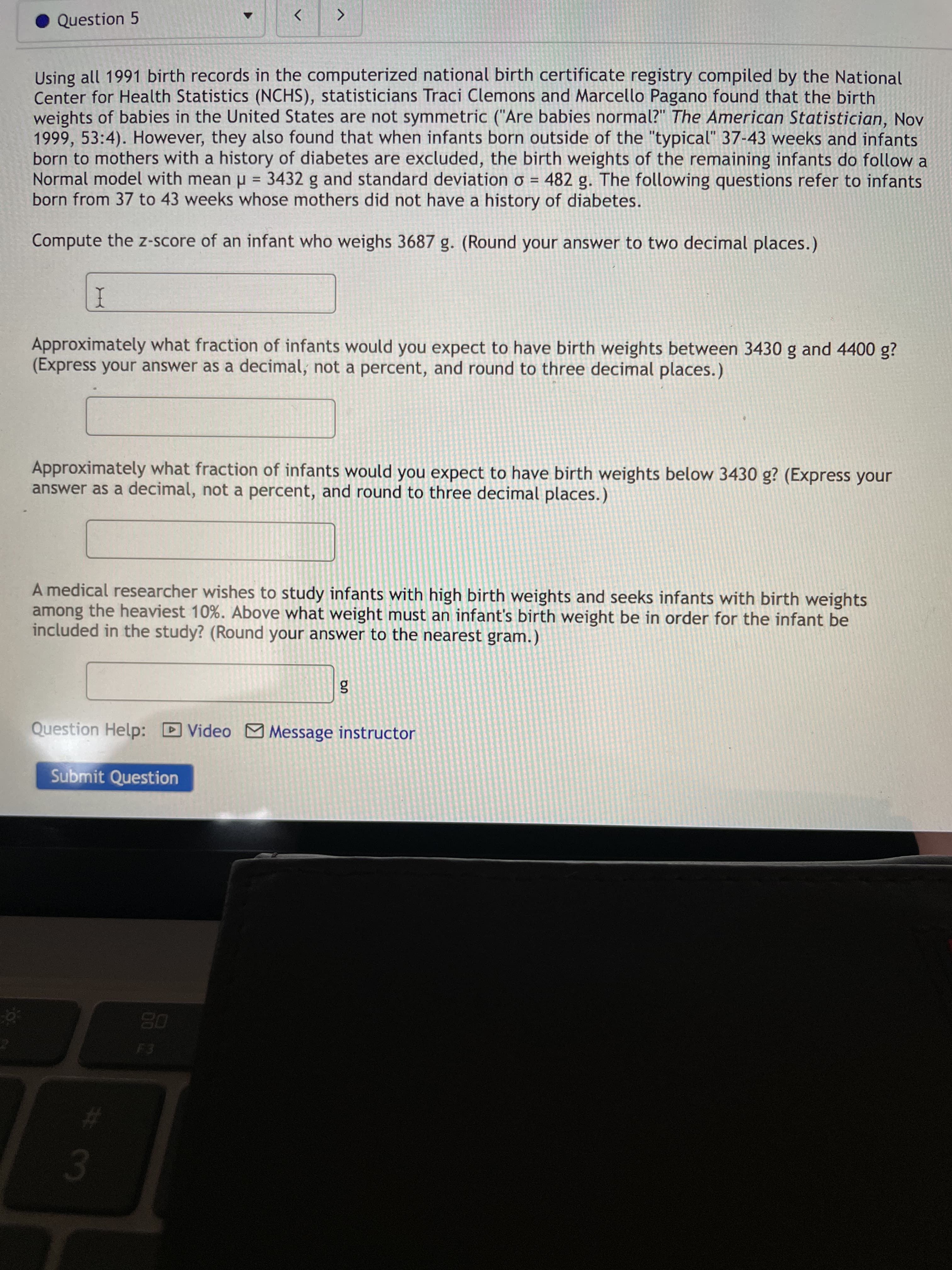Using all 1991 birth records in the computerized national birth certificate registry compiled by the National Center for Health Statistics (NCHS), statisticians Traci Clemons and Marcello Pagano found that the birth weights of babies in the United States are not symmetric ("Are babies normal?" The American Statistician, Nov 1999, 53:4). However, they also found that when infants born outside of the "typical" 37-43 weeks and infants born to mothers with a history of diabetes are excluded, the birth weights of the remaining infants do follow a Normal model with mean u = 3432 g and standard deviation o = born from 37 to 43 weeks whose mothers did not have a history of diabetes. 482 g. The following questions refer to infants %3D
Using all 1991 birth records in the computerized national birth certificate registry compiled by the National Center for Health Statistics (NCHS), statisticians Traci Clemons and Marcello Pagano found that the birth weights of babies in the United States are not symmetric ("Are babies normal?" The American Statistician, Nov 1999, 53:4). However, they also found that when infants born outside of the "typical" 37-43 weeks and infants born to mothers with a history of diabetes are excluded, the birth weights of the remaining infants do follow a Normal model with mean u = 3432 g and standard deviation o = born from 37 to 43 weeks whose mothers did not have a history of diabetes. 482 g. The following questions refer to infants %3D
Functions and Change: A Modeling Approach to College Algebra (MindTap Course List)
6th Edition
ISBN:9781337111348
Author:Bruce Crauder, Benny Evans, Alan Noell
Publisher:Bruce Crauder, Benny Evans, Alan Noell
Chapter5: A Survey Of Other Common Functions
Section5.3: Modeling Data With Power Functions
Problem 6E: Urban Travel Times Population of cities and driving times are related, as shown in the accompanying...
Related questions
Question
Help. Please

Transcribed Image Text:# 3
Question 5
<>
Using all 1991 birth records in the computerized national birth certificate registry compiled by the National
Center for Health Statistics (NCHS), statisticians Traci Clemons and Marcello Pagano found that the birth
weights of babies in the United States are not symmetric ("Are babies normal?" The American Statistician, Nov
1999, 53:4). However, they also found that when infants born outside of the "typical" 37-43 weeks and infants
born to mothers with a history of diabetes are excluded, the birth weights of the remaining infants do follow a
Normal model with mean u = 3432 g and standard deviation o = 482 g. The following questions refer to infants
born from 37 to 43 weeks whose mothers did not have a history of diabetes.
%3D
Compute the z-score of an infant who weighs 3687 g. (Round your answer to two decimal places.)
I
Approximately what fraction of infants would you expect to have birth weights between 3430 g and 4400 g?
(Express your answer as a decimal, not a percent, and round to three decimal places.)
Approximately what fraction of infants would you expect to have birth weights below 3430 g? (Express your
answer as a decimal, not a percent, and round to three decimal places.)
A medical researcher wishes to study infants with high birth weights and seeks infants with birth weights
among the heaviest 10%. Above what weight must an infant's birth weight be in order for the infant be
included in the study? (Round your answer to the nearest gram.)
Question Help: D Video M Message instructor
Submit Question
08
Expert Solution
This question has been solved!
Explore an expertly crafted, step-by-step solution for a thorough understanding of key concepts.
This is a popular solution!
Trending now
This is a popular solution!
Step by step
Solved in 5 steps

Recommended textbooks for you

Functions and Change: A Modeling Approach to Coll…
Algebra
ISBN:
9781337111348
Author:
Bruce Crauder, Benny Evans, Alan Noell
Publisher:
Cengage Learning

Algebra & Trigonometry with Analytic Geometry
Algebra
ISBN:
9781133382119
Author:
Swokowski
Publisher:
Cengage

Glencoe Algebra 1, Student Edition, 9780079039897…
Algebra
ISBN:
9780079039897
Author:
Carter
Publisher:
McGraw Hill

Functions and Change: A Modeling Approach to Coll…
Algebra
ISBN:
9781337111348
Author:
Bruce Crauder, Benny Evans, Alan Noell
Publisher:
Cengage Learning

Algebra & Trigonometry with Analytic Geometry
Algebra
ISBN:
9781133382119
Author:
Swokowski
Publisher:
Cengage

Glencoe Algebra 1, Student Edition, 9780079039897…
Algebra
ISBN:
9780079039897
Author:
Carter
Publisher:
McGraw Hill